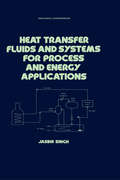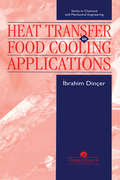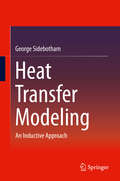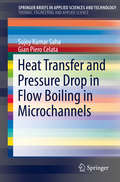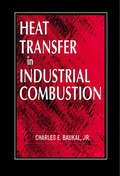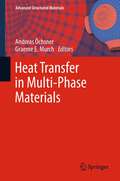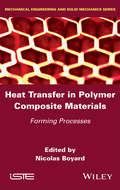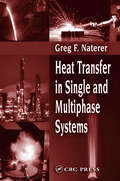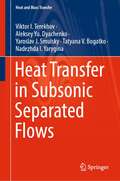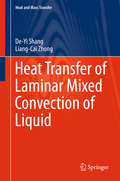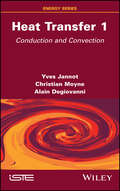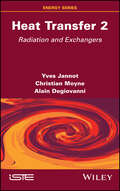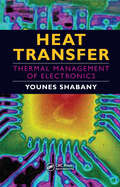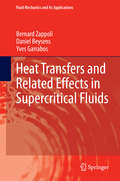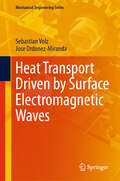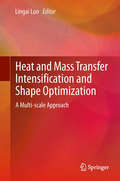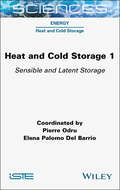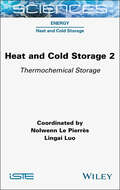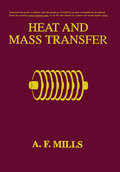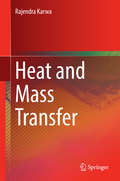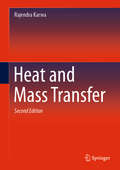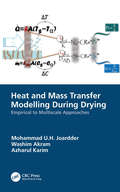- Table View
- List View
Heat Transfer Fluids and Systems for Process and Energy Applications
by Jasbir SinghThis book presents the basic principles and engineering data governing the process design of indirect heat transfer fluids and systems. It focuses on the selection of systems based on common engineering criteria such as reliability and cost, and particularly on energy conservation and safety.
Heat Transfer In Food Cooling Applications
by Ibrahim DincerThis comprehensive book is a valuable and readable reference text and source for anyone who wishes to learn about food cooling applications and methods of analysis of the heat transfer during these applications.
Heat Transfer Modeling
by George SidebothamThis innovative text emphasizes a "less-is-more" approach to modeling complicated systems such as heat transfer by treating them first as "1-node lumped models" that yield simple closed-form solutions. The author develops numerical techniques for students to obtain more detail, but also trains them to use the techniques only when simpler approaches fail. Covering all essential methods offered in traditional texts, but with a different order, Professor Sidebotham stresses inductive thinking and problem solving as well as a constructive understanding of modern, computer-based practice. Readers learn to develop their own code in the context of the material, rather than just how to use packaged software, offering a deeper, intrinsic grasp behind models of heat transfer. Developed from over twenty-five years of lecture notes to teach students of mechanical and chemical engineering at The Cooper Union for the Advancement of Science and Art, the book is ideal for students and practitioners across engineering disciplines seeking a solid understanding of heat transfer. This book also: · Adopts a novel inductive pedagogy where commonly understood examples are introduced early and theory is developed to explain and predict readily recognized phenomena · Introduces new techniques as needed to address specific problems, in contrast to traditional texts' use of a deductive approach, where abstract general principles lead to specific examples · Elucidates readers' understanding of the "heat transfer takes time" idea--transient analysis applications are introduced first and steady-state methods are shown to be a limiting case of those applications · Focuses on basic numerical methods rather than analytical methods of solving partial differential equations, largely obsolete in light of modern computer power · Maximizes readers' insights to heat transfer modeling by framing theory as an engineering design tool, not as a pure science, as has been done in traditional textbooks · Integrates practical use of spreadsheets for calculations and provides many tips for their use throughout the text examples
Heat Transfer Physics, Second Edition
by Massoud KavianyThis graduate textbook describes atomic-level kinetics (mechanisms and rates) of thermal energy storage, transport (conduction, convection, and radiation), and transformation (various energy conversions) by principal energy carriers. The approach combines the fundamentals of molecular orbitals-potentials, statistical thermodynamics, computational molecular dynamics, quantum energy states, transport theories, solid-state and fluid-state physics, and quantum optics. The textbook presents a unified theory, over fine-structure/molecular-dynamics/Boltzmann/macroscopic length and time scales, of heat transfer kinetics in terms of transition rates and relaxation times, and its modern applications, including nano- and microscale size effects. Numerous examples, illustrations, and homework problems with answers to enhance learning are included. This new edition includes applications in energy conversion (including chemical bond, nuclear, and solar), expanded examples of size effects, inclusion of junction quantum transport, and discussion of graphene and its phonon and electronic conductances. New appendix coverage of Phonon Contributions Seebeck Coefficient and Monte Carlo Methods are also included.
Heat Transfer and Pressure Drop in Flow Boiling in Microchannels
by Sujoy Kumar Saha Gian Piero CelataThis Brief addresses the phenomena of heat transfer and pressure drop in flow boiling in micro channels occurring in high heat flux electronic cooling. A companion edition in the Springer Brief Subseries on Thermal Engineering and Applied Science to "Critical Heat Flux in Flow Boiling in Micro channels," by the same author team, this volume is idea for professionals, researchers and graduate students concerned with electronic cooling.
Heat Transfer in Industrial Combustion
by Charles E. Baukal Jr.Industry relies heavily on the combustion process. The already high demand for energy, primarily from combustion, is expected to continue to rapidly increase. Yet, the information is scattered and incomplete, with very little attention paid to the overall combustion system. Designed for practicing engineers, Heat Transfer in Industrial Combustion e
Heat Transfer in Multi-Phase Materials
by Andreas Öchsner Graeme E. MurchThis book provides a profound understanding, which physical processes and mechanisms cause the heat transfer in composite and cellular materials. It shows models for all important classes of composite materials and introduces into the latest advances. In three parts, the book covers Composite Materials (Part A), Porous and Cellular Materials (Part B) and the appearance of a conjoint solid phase and fluid aggregate (Part C).
Heat Transfer in Polymer Composite Materials: Forming Processes
by Nicolas BoyardThis book addresses general information, good practices and examples about thermo-physical properties, thermo-kinetic and thermo-mechanical couplings, instrumentation in thermal science, thermal optimization and infrared radiation.
Heat Transfer in Single and Multiphase Systems
by Greg F. NatererExtensively revised and thoroughly updated, this popular text de-emphasizes high level mathematics in favor of effective, accurate modeling. Real-world examples amplify the theory and show how to use derived equations to model physical problems. Exercises that parallel the examples build readers' confidence and prepare them to confront the more com
Heat Transfer in Subsonic Separated Flows (Heat and Mass Transfer)
by Viktor I. Terekhov Aleksey Yu. Dyachenko Yaroslav J. Smulsky Tatyana V. Bogatko Nadezhda I. YaryginaThis book presents the results of scientific research performed over the past two decades by the authors. The book discusses some issues of separated laminar flows that are of great practical interest for the development of new technologies using microchannel flows, where separation zones can form. Of particular interest is the complex mechanism of flow separation with superimposed high external turbulence. The challenges of finding the optimal location for the cavities and fins on heat exchange surfaces are also considered. This is an important fundamental and practical problem when creating new schemes of efficient heat exchangers in various power plants. A wide class of problems of turbulent flow in tubes with flow separation is considered. These data will be useful in engineering estimates of the thermal–hydraulic efficiency of various heat transfer intensifiers. This book focuses on the analysis of thermal characteristics of separated flows, as well as the possibility of controlling the intensity of heat exchange processes, from the point of view of both their intensification and their suppression.
Heat Transfer of Laminar Mixed Convection of Liquid
by De-Yi Shang Liang-Cai ZhongThis book presents a new algorithm to calculate fluid flow and heat transfer of laminar mixed convection. It provides step-by-step tutorial help to learn quickly how to set up the theoretical and numerical models of laminar mixed convection, to consider the variable physical properties of fluids, to obtain the system of numerical solutions, to create a series of formalization equations for the convection heat transfer by using a curve-fitting approach combined with theoretical analysis and derivation. It presents the governing ordinary differential equations of laminar mixed convection, equivalently transformed by an innovative similarity transformation with the description of the related transformation process. A system of numerical calculations of the governing ordinary differential equations is presented for the water laminar mixed convection. A polynomial model is induced for convenient and reliable treatment of variable physical properties of liquids. The developed formalization equations of mixed convection heat transfer coefficient have strong theoretical and practical value for heat transfer applications because they are created based on a better consideration of variable physical properties of fluids, accurate numerical solutions and rigorous formalization equations combined with rigorous theoretical derivation. This book is suitable for scientific researchers, engineers, professors, master and PhD students of fluid mechanics and convection heat and mass transfer.
Heat Transfer to Non-Newtonian Fluids: Fundamentals and Analytical Expressions
by Aroon ShenoyThis book has been written with the idea of providing the fundamentals for those who are interested in the field of heat transfer to non-Newtonian uids. It is well recognized that non-Newtonian fluids are encountered in a number of transport processes and estimation of the heat transfer characteristics in the presence of these fl uids requires analysis of equations that are far more complex than those encountered for Newtonian fl uids. A deliberate effort has be made to demonstrate the methods of simplication of the complex equations and to put forth analytical expressions for the various heat transfer situations in as vivid manner as possible. The book covers a broad range of topics from forced, naturaland mixed convection without and with porous media. Laminaras well as turbulent flow heat transfer to non-Newtonian fluids have been treated and the criterion for transition from laminar toturbulent fl ow for natural convection has been established. The heat transfer characteristics of non-Newtonian fl uids from inelastic power-law fluids to viscoelastic second-order fluids and mildly elastic drag reducing fl uids are covered. This book can serve the needs of undergraduates, graduates and industry personnel from the fields of chemical engineering, material science and engineering, mechanical engineering and polymer engineering.
Heat Transfer, Volume 1: Conduction and Convection
by Yves Jannot Alain Degiovanni Christian MoyneHeat Transfer 1 deals with conduction and convection. It examines the treatment of transient conduction, which is essential for the optimization of processes and systems, as well as for all energy saving problems. The numerous solved exercises allow the reader to grasp the whole range of applications, whether in the field of building, transport, materials or the environment. The appendices contain all the data needed to solve the exercises and will be a valuable source of information. This book is designed for masters and engineering students who are interested in all aspects of heat transfer, but also for engineers who will find the bases needed to understand similar phenomena (conduction-convection-radiation), but which require a different form of reflection and approach.
Heat Transfer, Volume 2: Radiation and Exchangers
by Yves Jannot Alain Degiovanni Christian MoyneHeat Transfer 2 deals with radiation, heat exchangers and flat plate solar collectors. It presents the treatment of radiation in semi-transparent media to be taken into account for insulation or recovery of high temperature waste heat (energy saving in industry), as well as in certain solar applications (energy transition). The numerous solved exercises allow the reader to grasp the whole range of applications, whether in the field of building, transport, materials or the environment. The appendices contain all the data needed to solve the exercises and will be a valuable source of information. This book is designed for masters and engineering students who are interested in all aspects of heat transfer, but also for engineers who will find the bases needed to understand similar phenomena (conduction-convection-radiation), but which require a different form of reflection and approach.
Heat Transfer: Thermal Management of Electronics
by Younes ShabanyThe continuing trend toward miniaturization and high power density electronics results in a growing interdependency between different fields of engineering. In particular, thermal management has become essential to the design and manufacturing of most electronic systems.Heat Transfer: Thermal Management of Electronics details how engineers can use
Heat Transfers and Related Effects in Supercritical Fluids
by Daniel Beysens Bernard Zappoli Yves GarrabosThis book investigates the unique hydrodynamics and heat transfer problems that are encountered in the vicinity of the critical point of fluids. Emphasis is given on weightlessness conditions, gravity effects and thermovibrational phenomena. Near their critical point, fluids indeed obey universal behavior and become very compressible and expandable. Their comportment, when gravity effects are suppressed, becomes quite unusual. The problems that are treated in this book are of interest to students and researchers interested in the original behavior of near-critical fluids as well as to engineers that have to manage supercritical fluids. A special chapter is dedicated to the present knowledge of critical point phenomena. Specific data for many fluids are provided, ranging from cryogenics (hydrogen) to high temperature (water). Basic information in statistical mechanics, mathematics and measurement techniques is also included. The basic concepts of fluid mechanics are given for the non-specialists to be able to read the parts he is interested in. Asymptotic theory of heat transfer by thermoacoustic processes is provided with enough details for PhD students or researchers and engineers to begin in the field. Key spaces are described in details, with many comparisons between theory and experiments to illustrate the topics.
Heat Transport Driven by Surface Electromagnetic Waves (Mechanical Engineering Series)
by Sebastian Volz Jose Ordonez-MirandaThis book leads the reader from the well-established wave description of polaritons to their particle description to quantify the polariton contribution to the heat transport along polar and metallic nanofilms, nanowires, and cavities. Over the last few decades, the surface electromagnetic waves propagating along the interface of metals (plasmon polaritons) and polar dielectrics (phonon polaritons) have been widely studied to generate and guide energy currents. And while the optical generation of these polaritons at a given frequency is well known and exploited nowadays, their thermal excitation and propagation in a broad frequency spectrum, explored in detail in this volume, have only more recently been emerging as an effective way to enhance conductive and radiative heat currents. Written by the foremost experts and researchers in nanoscale heat transport, this book consolidates in a single comprehensive view, the findings on surface electromagnetic waves as the 4th heat carriers, besides phonons, photons, and electrons.
Heat and Mass Transfer Intensification and Shape Optimization
by Lingai LuoIs the heat and mass transfer intensification defined as a new paradigm of process engineering, or is it just a common and old idea, renamed and given the current taste? Where might intensification occur? How to achieve intensification? How the shape optimization of thermal and fluidic devices leads to intensified heat and mass transfers? To answer these questions, Heat & Mass Transfer Intensification and Shape Optimization: A Multi-scale Approach clarifies the definition of the intensification by highlighting the potential role of the multi-scale structures, the specific interfacial area, the distribution of driving force, the modes of energy supply and the temporal aspects of processes. A reflection on the methods of process intensification or heat and mass transfer enhancement in multi-scale structures is provided, including porous media, heat exchangers, fluid distributors, mixers and reactors. A multi-scale approach to achieve intensification and shape optimization is developed and clearly explained. Providing readers with a tool box of reflections, techniques, methods, supported by literature reviews, Heat & Mass Transfer Intensification and Shape Optimization: A Multi-scale Approach will be a key guide for students, a teaching aid for lecturers and a source of inspiration for future research subjects.
Heat and Cold Storage, Volume 1: Sensible and Latent Storage (ISTE Consignment)
by Pierre Odru Elena Palomo del BarrioHeat and Cold Storage 1 is dedicated to sensible and latent heat storage processes. Beginning with some theoretical reminders, this book presents the main situations of low-temperature and high-temperature sensible storage for electricity generation. It also analyzes latent storage on phase-change materials (PCMs) from a fundamental standpoint, presenting the mechanisms to prepare PCMs and their integration into heat and cold storage processes. The most promising materials are presented, along with ways of improving the materials studied. Notions of technico-economic profitability are also defined. Finally, the book looks at heat storage in thermodynamic solar power plants and the wide variety of physical storage principles involved.
Heat and Cold Storage, Volume 2: Thermochemical Storage (ISTE Consignment)
by Lingai Luo Nolwenn Le PierrèsHeat and Cold Storage 2 focuses on thermochemical sorption storage processes – that is, absorption, adsorption and chemical sorption. This book first analyzes the principles of sorption and defines the criteria for selecting the materials to be used, before presenting the three sorption storage technologies. It details the functioning of the absorption cycle in order to highlight the future challenges of this method. Next, the book examines storage by physical adsorption. Then, it presents the fundamentals of this phenomenon and a description of solid-gas adsorption cycles and systems, followed by a number of examples of prototype installations. Finally, the book describes the phenomenon of heat storage by chemical sorption from the scale of the reactive material to the scale of the process, before putting the state of the art of possible improvements into perspective and illustrating various applications.
Heat and Mass Transfer
by Anthony MillsThis complete reference book covers topics in heat and mass transfer, containing extensive information in the form of interesting and realistic examples, problems, charts, tables, illustrations, and more. Heat and Mass Transfer emphasizes practical processes and provides the resources necessary for performing accurate and efficient calculations.This excellent reference comes with a complete set of fully integrated software available for download at crcpress.com, consisting of 21 computer programs that facilitate calculations, using procedures developed in the text. Easy-to-follow instructions for software implementation make this a valuable tool for effective problem-solving.
Heat and Mass Transfer
by Rajendra KarwaThis textbook presents the classical treatment of the problems of heat transfer in an exhaustive manner with due emphasis on understanding of the physics of the problems. This emphasis is especially visible in the chapters on convective heat transfer. Emphasis is laid on the solution of steady and unsteady two-dimensional heat conduction problems. Another special feature of the book is a chapter on introduction to design of heat exchangers and their illustrative design problems. A simple and understandable treatment of gaseous radiation has been presented. A special chapter on flat plate solar air heater has been incorporated that covers thermo-hydraulic modeling and simulation. The chapter on mass transfer has been written looking specifically at the needs of the students of mechanical engineering. The book includes a large number and variety of solved problems with supporting line diagrams. The author has avoided duplicating similar problems, while incorporating more application-based examples. All the end-of-chapter exercise problems are supplemented with stepwise answers. Primarily designed to serve as a complete textbook for undergraduate and graduate students of mechanical engineering, the book will also be useful for students of chemical, automobile, production, and industrial engineering streams. The book fully covers the topics of heat transfer coursework and can also be used as reference for students preparing for competitive graduate examinations.
Heat and Mass Transfer
by Rajendra KarwaThis textbook presents the classical treatment of the problems of heat transfer in an exhaustive manner with due emphasis on understanding of the physics of the problems. This emphasis will be especially visible in the chapters on convective heat transfer. Emphasis is also laid on the solution of steady and unsteady two-dimensional heat conduction problems. Another special feature of the book is a chapter on introduction to design of heat exchangers and their illustrative design problems. A simple and understandable treatment of gaseous radiation has been presented. A special chapter on flat plate solar air heater has been incorporated that covers mathematical modeling of the air heater. The chapter on mass transfer has been written looking specifically at the needs of the students of mechanical engineering. The book includes a large number and variety of solved problems with supporting line diagrams. A number of application-based examples have been incorporated where applicable. The end-of-chapter exercise problems are supplemented with stepwise answers. Though the book has been primarily designed to serve as a complete textbook for undergraduate and graduate students of mechanical engineering, it will also be useful for students of chemical, aerospace, automobile, production, and industrial engineering streams. The book fully covers the topics of heat transfer coursework and can also be used as an excellent reference for students preparing for competitive graduate examinations.
Heat and Mass Transfer Modelling During Drying: Empirical to Multiscale Approaches
by Azharul Karim Mohammad U.H. Joardder Washim AkramMost conventional dryers use random heating to dry diverse materials without considering their thermal sensitivity and energy requirements for drying. Eventually, excess energy consumption is necessary to attain a low-quality dried product. Proper heat and mass transfer modelling prior to designing a drying system for selected food materials can overcome these problems. Heat and Mass Transfer Modelling During Drying: Empirical to Multiscale Approaches extensively discusses the issue of predicting energy consumption in terms of heat and mass transfer simulation. A comprehensive mathematical model can help provide proper insight into the underlying transport phenomena within the materials during drying. However, drying of porous materials such as food is one of the most complex problems in the engineering field that is also multiscale in nature. From the modelling perspective, heat and mass transfer phenomena can be predicted using empirical to multiscale modelling. However, multiscale simulation methods can provide a comprehensive understanding of the physics of drying food materials. KEY FEATURES Includes a detailed discussion on material properties that are relevant for drying phenomena Presents an in-depth discussion on the underlying physics of drying using conceptual visual content Provides appropriate formulation of mathematical modelling from empirical to multiscale approaches Offers numerical solution approaches to mathematical models Presents possible challenges of different modelling strategies and potential solutions The objective of this book is to discuss the implementation of different modelling techniques ranging from empirical to multiscale in order to understand heat and mass transfer phenomena that take place during drying of porous materials including foods, pharmaceutical products, paper, leather materials, and more.
